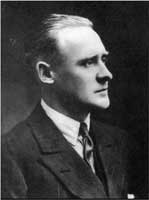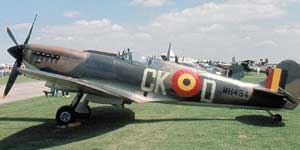| |
The most famous
military aircraft of all time and one of the most beautiful
ever built, the Spitfire is perhaps chiefly remembered
as the symbol of the Battle of Britain. The Spitfire was
developed by Supermarine’s brilliant chief designer, R.J.
Mitchell, and was the only British type in continuous
construction throughout World War II. The RAF’s first
Spitfires were delivered to No 19 Squadron at Duxford
in 1938 and by July 1940, on the eve of the Battle of
Britain, nineteen RAF squadrons were equipped with the
new fighter. During WWII, thanks to constant improvements
and modifications, the Spitfire was never outclassed as
a short-ranged piston-engined interceptor apart from a
brief period in 1941-1942, when it first encountered the
Focke-Wulf FW-190. When production finally ceased in 1949,
more than 22,000 Spitfires and Seafires (the naval version
of the Spitfire) had been built in some forty different
variants.
Perhaps the most famous
of all Spitfires still flying today, MH434 was built
in 1943 at Vickers, Castle Bromwich. This Spitfire is
completely original, and has never been fully rebuilt.
A delight to fly, the aircraft is beautifully responsive
and extremely manoeuvrable.
|
 |
|
| |
Within the month
MH434 was scoring with 222 Squadron. It was flown in
combat by South African pilot Flt Lt Henry Lardner-Burke,
DFC (1916-1970), seven and a half kills, three damaged,
retiring as a Wing Commander. On the 27 August in the
St Omar area over France, Lardner-Burke shot down a
Focke-Wulf FW-190 and damaged a second during a mission
to escort USAAF B-17 bombers. On the 5 September 1943
Lardner-Burke and MH434 shot down another FW-190 in
the Nieuport area, and on the 8 September 1943 claimed
a half share in the downing of a Messerschmitt Bf-109G
in Northern France.
In 1944 MH434 was transferred
to 350 Sqn. Hornchurch, before being returned to 222
Sqn. After 79 operational sorties, MH434 was retired
in March 1945.
MH434’s guns were loaded again
when bought by the Royal Netherlands Air Force in 1947.
The Spitfire served with 322 Sqn. As H-105 - mainly
ground strafing and light bombing missions - before
crash-landing in Semarang, Java. After spending some
time in storage, MH434 was repaired and flew again in
Holland on the 10 March 1953.
|
|
| |
 |
The Belgian Air
Force became the next owner of this Spitfire, and as
SM-41 she served at the Advanced Pilot School at Koksijde
and with 13 Wing at Brustem.
On the 26 March 1956 MH434 was
put up for sale and bought and brought back to Britain
by airline pilot Tim Davies. As G-ASJV the Spitfire
was moved to Stansted then Elstree for a full overhaul.
The aircraft was flown purely for pleasure and took
part in it's first movie role, Operation Crossbow.
November 1967 saw MH434 join the motion picture airforce
of Spitfire Productions Ltd. Set up by Group Captain
Hamish Mahaddie for the film “Battle of Britain”.
|
|
| |
At the end of
the movie in 1968 MH434 was sold again. The new owner,
Sir Adrian Swire, Chairman of Cathay Pacific Airways,
had the Spitfire painted in 1944 camouflage colour scheme
with his initials AC-S, as squadron codes. There were
several film and television appearances during this
period, including “A Bridge Too Far”.
In April 1983 MH434 was sold at auction to the present
and illustrious owner, Ray Hanna (Nalfire Aviation Ltd)
and became one of OFMC’s founding aircraft. The first
major rebuild took place in the winter of 1994-95. MH434
has become a regular movie co-star and airshow performer
and when not in make up for a role is flown in the authentic
222 Sqn. Codes ZD-B.
Registration: G-ASJV
This text is from the OFMC website
http://www.ofmc.co.uk
|
|
|